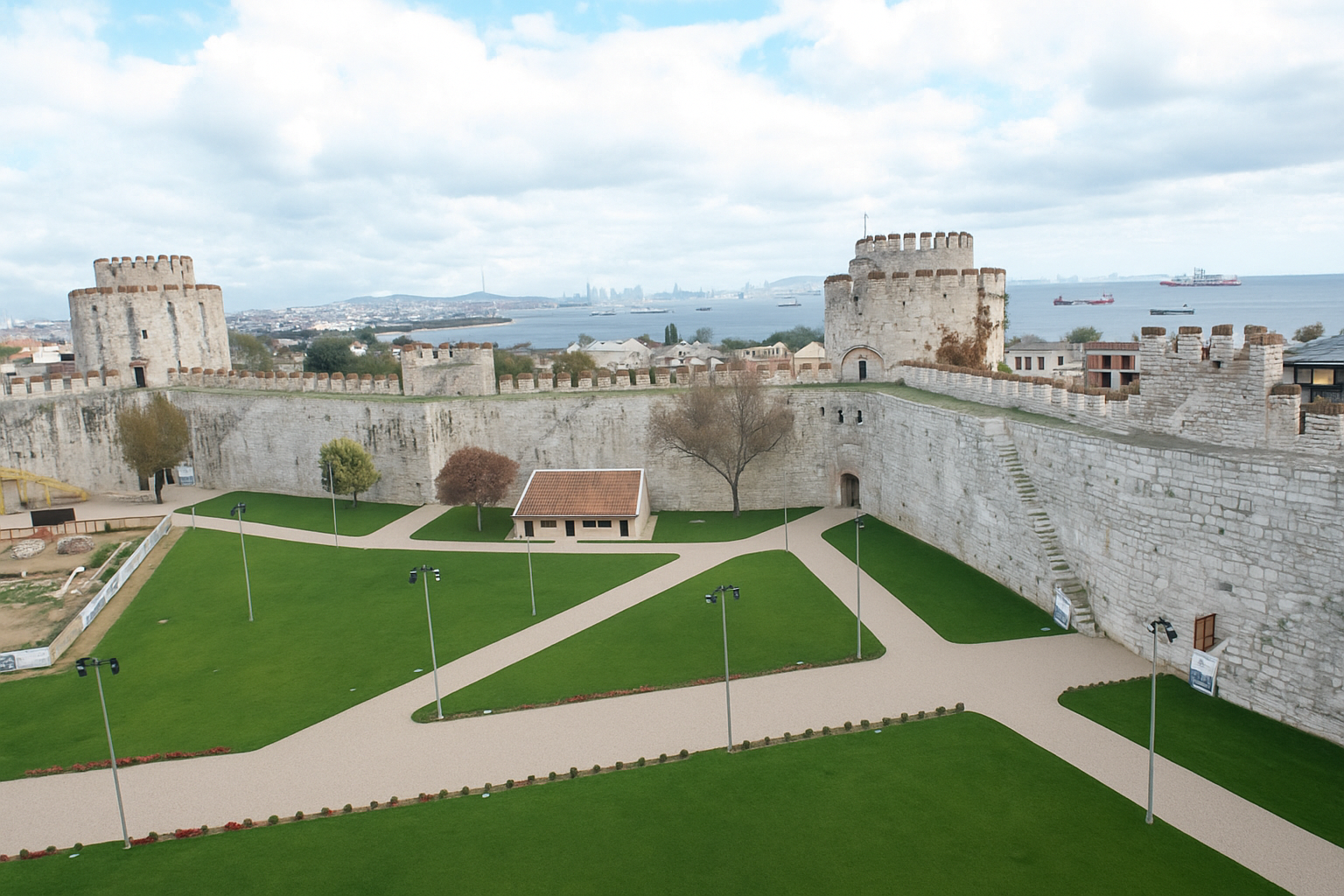
Yedikule Zindanları (Yedikule Fortress)
HISTORICAL BACKGROUND AND SIGNIFICANCE
Yedikule Zindanları, or Yedikule Fortress, is a monumental structure located on the outskirts of Istanbul, originally built in the 5th century during the reign of Byzantine Emperor Theodosius II. The fortress was initially part of the city’s defensive walls, designed to protect the capital from invasions. Its name, which translates to "Seven Towers," refers to the seven towers that were constructed as part of the fortification system. Over the centuries, Yedikule has served various purposes, including a royal palace, a prison, and a treasury, reflecting the tumultuous history of Istanbul itself.
In 1453, following the conquest of Constantinople by the Ottomans, Yedikule became a significant military stronghold. It was here that many notable prisoners were held, including the famous Ottoman Grand Vizier, Piri Reis, who was imprisoned after a failed naval campaign. The fortress also played a vital role in the administration of the city, serving as a customs house where goods entering the city were taxed.
ARCHITECTURAL FEATURES AND DESIGN ELEMENTS
The architecture of Yedikule Fortress is a stunning example of Byzantine and Ottoman military design. The fortress is constructed from large blocks of stone, featuring a series of massive walls that are up to 12 meters thick in some places. The main entrance is flanked by two imposing towers, which were strategically designed to provide a vantage point for spotting approaching enemies.
Inside, visitors will find a series of interconnected chambers and passageways, many of which still bear the scars of time. The most notable feature is the central courtyard, surrounded by the fortress's towering walls. The towers, each with their unique design, are adorned with battlements and arrow slits, showcasing the military ingenuity of the time. The fortress also includes a well-preserved chapel, which reflects the Byzantine influence on the structure.
CULTURAL AND RELIGIOUS IMPORTANCE
Yedikule Fortress holds significant cultural and religious importance in Istanbul. Originally built as a Christian fortification, it later transformed into an Islamic stronghold after the Ottoman conquest. The fortress symbolizes the city’s transition from Byzantine to Ottoman rule and serves as a testament to the diverse cultural heritage of Istanbul.
The chapel within the fortress, dedicated to St. John, is a reminder of the Byzantine Christian roots of the city. Over the centuries, Yedikule has been a site of various cultural events, including poetry readings and art exhibitions, further solidifying its role as a cultural landmark in modern Istanbul.
VISITOR EXPERIENCE AND WHAT TO EXPECT
Visiting Yedikule Fortress offers a unique opportunity to step back in time and explore the rich history of Istanbul. Upon arrival, visitors are greeted by the impressive exterior of the fortress, which stands as a testament to the city’s storied past. Inside, the atmosphere is both haunting and captivating, with echoes of history resonating through the ancient stone walls.
As you wander through the fortress, you can explore the various towers, each offering panoramic views of the surrounding area, including the Sea of Marmara and the historic city of Istanbul. The central courtyard often hosts art installations and cultural events, providing a lively contrast to the fortress's somber history.
Guided tours are available, offering deeper insights into the fortress's history and architecture. Visitors can also enjoy a small café within the grounds, perfect for taking a break and soaking in the views.
INTERESTING FACTS AND ANECDOTES
- Yedikule Fortress is rumored to be haunted by the spirits of prisoners who were held within its dark cells. Many visitors report feeling an eerie presence as they explore the dungeons. - The fortress was used as a filming location for several Turkish films, adding to its cultural significance in contemporary media. - The name "Yedikule" is derived from the seven towers that were originally part of the fortress, though today only a few remain intact. - The fortress has witnessed numerous historical events, including the fall of Constantinople, and has been a silent observer of the city’s transformation over the centuries.
PRACTICAL VISITING INFORMATION
- **Hours of Operation:** Yedikule Fortress is open to visitors daily from 9:00 AM to 7:00 PM during the summer months (April to October) and from 9:00 AM to 5:00 PM during the winter months (November to March). - **Best Times to Visit:** The best time to visit is during the early morning or late afternoon when the light is perfect for photography, and the crowds are thinner. - **Tips for Visitors:** Wear comfortable shoes, as the fortress has uneven surfaces and steep stairs. Bring a camera to capture the stunning views from the towers. Consider joining a guided tour for a more in-depth understanding of the fortress's history. - **Getting There:** Yedikule Fortress is easily accessible by public transport. The nearest metro station is "Yenikapı," followed by a short bus ride or a 20-minute walk to the fortress. Taxis are also readily available throughout the city.
In conclusion, Yedikule Zindanları is not just a fortress; it is a living museum that encapsulates the essence of Istanbul's rich history and cultural diversity. Whether you are a history buff, an architecture enthusiast, or simply looking for a unique experience in Istanbul, Yedikule Fortress promises to leave a lasting impression.